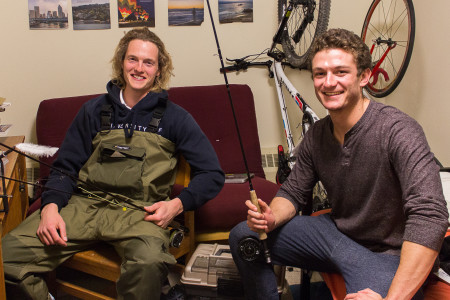
Photo by Sarah Ruiz.
Lily Bohlke, Copy Editor
bohlkeli@grinnell.edu
If you’ve ever dreamed of casting a weighted line with a weightless fly out into an open body of water in search of fish, Grinnell has just the club for you.
The fly fishing club, recently started by Stuart Hoegh ’17 and Jonathan Dowell ’18, plans to introduce the sport of fly-fishing to more Grinnellians. The sport, noted for its grace and portrayal in the film “A River Runs Through It,” has inspired the duo to pass on their knowledge to other would-be fly fisherpeople.
“Fly fishing is something we enjoy for its recreation and for its peacefulness. We find it to be therapeutic, almost, and we think it would be something college students, especially Grinnellians who are very open to new activities, would want to try,” Dowell said.
Hoegh began fly fishing the summer after his senior year of high school. He spent most of the summer practicing, culminating in a two-week trip with his friends where they fly fished in Montana.
Dowell learned the sport from his uncle in Wyoming, where they would take fly-fishing trips with guides who were very helpful in teaching new fly fishers how to cast effectively.
Fly fishing is a type of fishing that uses a longer rod and an artificial fly with a small hook instead of bait. The fly weighs little to nothing, which means the line itself must be weighted. To cast this line, the fisherperson must make big arcs through the air using special techniques.
“It takes a little bit of finesse, but it’s something just about anyone can learn,” Dowell noted. “The casting and motion itself has its own aesthetic to it — it’s visually pleasing.”
According to Hoegh, this type of fishing requires participants to be more actively involved in the process. Instead of passively waiting for a fish to grab bait, the fisherperson must focus all the time.
“You really have to focus on what you’re doing and that helps get your mind off of whatever you’re thinking about. For Grinnell students, it’s probably going to be homework or your job,” Hoegh said.
Although some students may avoid fishing for fear of hurting fish, Dowell and Hoegh assure participants that the hooks are so small that they do not hurt the fish and all of the fish get thrown back into the water. In fact, they avoid bringing the fish far out of the water at all.
Even though the flies used for the sport are commonly bought, they are relatively expensive and easy to lose, according to Hoegh, yet they are also easy and fun to make by hand. For example, fishing flies can be made out of feathers, animal fur or copper wires or beads. Subsequently, Hoegh says that he enjoys fly-tying recreationally.
“In the evenings, I’ll tie flies just to get my mind off things,” Hoegh said.
On Monday, April 11, Hoegh and Dowell submitted a budget with the hopes of acquiring funding to buy six rods and three fly-tying vises. The club plans to continue for semesters to come and GORP has agreed to store the fly-fishing materials.
Upon getting their funding, Hoegh and Dowell plan on teaching club participants how to cast: the most basic and important skill. They will also teach participants to tie flies that they will then use to fish. All this will be happening on campus on dry land, but eventually there are plans to go out to Rock Creek and catch panfish like bluegill. In May, the club will also make a trip out to Decorah, Iowa in search of different quarry.
“There are some trout rivers there,” Hoegh said. “We don’t have trout around here.”
Through the fly fishing club, Hoegh and Dowell hope to share their passion for the sport with other Grinnellians who might be interested in learning something new.
“One of our main goals is to education people and develop this as a life skill,” Dowell said.



















































